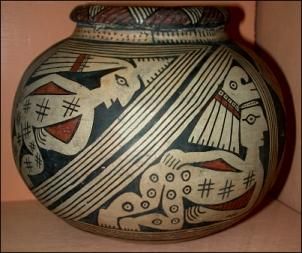
Carry it or forget it—a fact of life for early peoples of the Southwest. No beasts of burden and no wheels literally meant if you needed it, you carried it, so it is not surprising to discover that the early nomadic hunters and gatherers used baskets for vessels for thousands of years. However, with the advent of agriculture and sedentary village life, portability no longer was a prime consideration, and heavier, fragile pottery vessels began to join baskets as utility ware about 100 A.D. Almost certainly, the concept was imported from ceramic-using Mesoamerican civilizations, who had long since mastered the art.
Through time, the natives of the Southwest became adept potters, and
trade within the region and to the south became an important economic factor. These
trade goods embody recognizable local techniques of manufacture and design, allowing
tracing of ancient trade routes and determination of relative ages of the
pottery-producing cultures. Thus development of pottery in the Southwest resulted in an
easier life for both the inhabitants and modern-day archaeologists.

Listen to the Audio (mp3 format) as recorded by KTEP, Public Radio for the Southwest.
Contributor: Florence E. Schwein, University of Texas at El Paso.
Desert Diary is a joint production of the Centennial Museum and KTEP National Public Radio at the University of Texas at El Paso.

Ceramic from Casas Grandes, Chihuahua, Mexico. Centennial Museum collection. Photograph by A.H. Harris.
Hayes, A., and J. Blom. 1996. Southwestern Pottery: Anasazi to Zuni. Northland Publishing, Flagstaff, 189 pp.